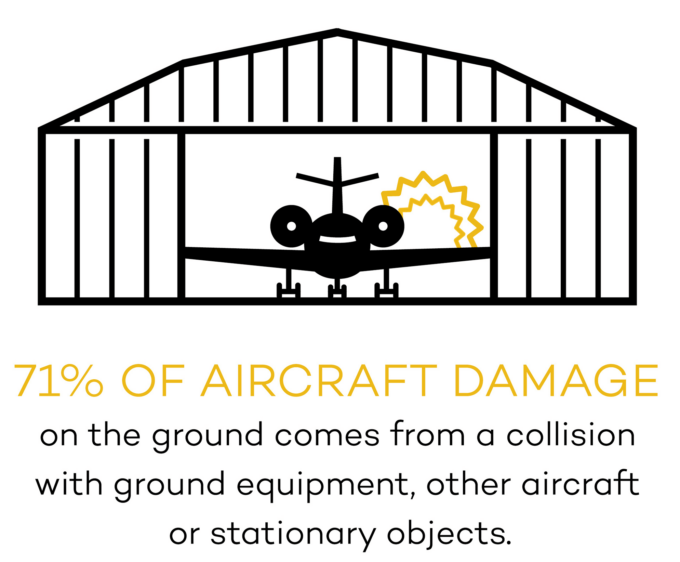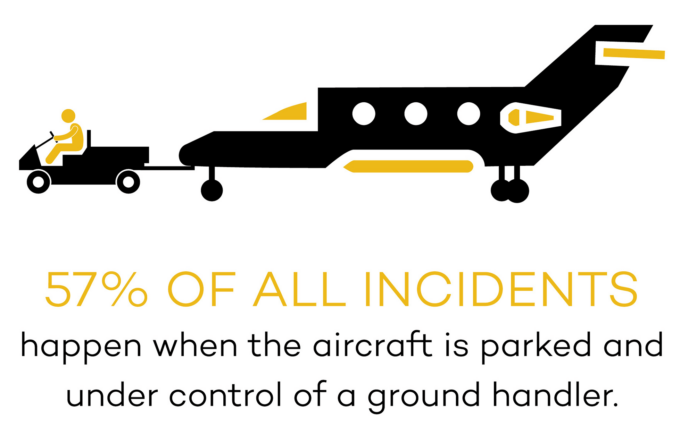Thousands of times each day, business aircraft move safely around airports worldwide. In fact, ground handling incidents remain a rare occurrence. But with the increased complexity of general aviation aircraft and the growing use of composites, the potential cost of an incident is growing exponentially.
Hangar rash, towing incidents, ground collisions and taxiing mishaps feature heavily in ground incident reports. According to the International Business Aviation Council (IBAC), 71% of aircraft damage comes from a collision with ground station equipment, other aircraft or static objects such as trees, lamp posts and hangars. IBAC also found that 57% of all incidents happen when the aircraft is parked and under control of a ground handler. This means that pilots might be able to positively influence more than 40% of all incidents.
“At the end of each flight, a pilot could take a few minutes writing up a report that could make a huge difference to the information operators have on FBOs and also serve as a signal to FBOs that pilots and operators are taking ground safety seriously.”
BOB SCHICK Director of Safety and Risk Management, TAC Air
The economic benefit of reducing ground handling incidents is tangible. According to Victor D’Avanzo, senior vice president and director of quality and process improvement at underwriter United States Aircraft Insurance Group (USAIG), the cost of repair may be the lowest cost of the overall loss if the ground handler is responsible for paying for the loss of use to the aircraft operator. The total cost to the ground handler could be even higher if it is held responsible to pay for diminution of aircraft value due to the damage. The cost of the repair itself can balloon if parts are hard to source or an aircraft is grounded for some time.
A Systematic Approach
The FBO industry is attempting to address the impact of ground handling incidents, and there is momentum among operators of all sizes to use safety management systems (SMS) to reduce losses. IBAC and the National Air Transportation Association (NATA) also have developed a global standard for FBOs and business aircraft handling agents (BAHAs) – the International Standard for Business Aircraft Handling (IS-BAH) – which is modeled after the successful International Standard for Business Aircraft Operations code of best practices.
While most ground incidents can be traced to a specific error, Michael France, NATA’s managing director of safety and training, argues that permanently reducing incident rates is not about simply listing specific offenses.
“We preach that it’s more important to work safely than quickly.”
CHRIS ROZANSKY Executive Director, Naples Airport Authority
“Safely moving an aircraft on a ramp once is easy, but what is difficult is doing that 10,000 times, day-in and day-out without incident,” explained France. “To be successful in reducing ground handling incidents, you must look at the issues systemically. You need to create a safety culture where people feel empowered to report hazards, you have to have a solid training program, and leadership must be fully engaged.”
Pilots can be part of such an approach, and it seems many are willing to participate. “You are seeing a different class of pilot that wants to know more about the operation. It’s not enough to stand by your aircraft while it’s fueled. We see more pilots becoming involved in putting the bird to bed safely,” says Bob Schick, director of safety and risk management at TAC Air.
“Crews also are an important and underutilized auditing resource for operators,” adds Schick. “Pilots visit FBOs every day, and they know how to determine a good ground operation. If you don’t see a marshal on or off the ramp, if there isn’t at least one wing walker on the ramp and two in the hangar, if there are no cones, or if an FBO is using wooden chocks instead of rubber chocks, there is a problem. These are simple, inexpensive ways to prevent damage that a pilot can easily observe.
“At the end of each flight, a pilot could take a few minutes writing up a report that could make a huge difference to the information operators have on FBOs and also serve as a signal to FBOs that pilots and operators are taking ground safety seriously,” Schick adds.

Source: International Business Aviation Council

Source: International Business Aviation Council
Haste Makes Waste
Speed has a major impact on the safety of ground operations, and here, too, pilots can contribute, says Chris Rozansky, executive director of Florida’s Naples Airport Authority, which operates its own FBO, Naples Aviation.
“When things get busy, some pilots can be assertive, and a less-experienced [ground crew] employee will feel this sense of urgency and may take shortcuts. We preach that it’s more important to work safely than quickly,” says Rozansky.
Operators also can influence the pace of ground handling with the use of prudent flight planning, according to Hardy Bullock, director of aviation and community services at California’s Truckee Tahoe Airport District, which also operates its own FBO.
“If an aircraft operator schedules an arrival 15 minutes before the FBO closes or sends an aircraft to the airport closest to the Super Bowl on the Friday before the game, then the potential for problems on the ramp certainly increases,” says Bullock.
A clear and open line of communication between an aircraft operator and an FBO also contributes to improved safety, adds Bullock.
“In a three-minute conversation, I can provide an operator enough information on noise abatement procedures, weather and hangar access to make arrival easier and get enough details from them to ensure their aircraft is in the right spot and ready to go when the pilot is,” he says.
Aircraft operators also should utilize existing resources to assess the safety of an FBO, says Schick of TAC Air. These include NATA’s FBO Status Map (fbostatus.com) and IBAC’s website (ibac.org), where operators can find a list of accredited IS-BAH operators. IBAC also sends updated links to this list to every IS-BAO-registered operator.
The Benefits of IS-BAH
TAC Air is IS-BAH-registered because “registration provides objective assurance that an FBO continually operates at the highest standard of safety,” says Schick. “IS-BAH not only establishes a global safety standard, it also authenticates a safety culture by providing third-party verification.”
Established in 2014, the IS-BAH standard offers FBOs and BAHAs a scalable, industry-developed code of best practices centered around SMS principles adopted by the International Civil Aviation Organization.
“IS-BAH helps organizations build a proactive approach to safety management and recognize that finding and fixing hazards and associated risks before they result in losses is a far more effective approach,” explains Terry Yeomans, IS-BAH’s program director. “The result is that ‘luck’ no longer plays a significant role in airside activities, and risks of hangar rash are mitigated,” he adds.
Aircraft operators and pilots reap the benefit of an FBO’s commitment to IS-BAH standards. The focus on enhanced safety also uncovers procedural and operational inefficiencies that, when corrected, ease an aircraft’s movement on the ground.
“IS-BAH helps organizations build a proactive approach to safety management and recognize that finding and fixing hazards and associated risks before they result in losses is a far more effective approach.”
TERRY YEOMANS IS-BAH Program Director, International Business Aviation Council
In addition, the data generated by an FBO registered with IS-BAH provides operators a measurable standard of performance, and the overall improvement of an FBO’s safety culture translates to a safer environment for the aircraft they service. Also, as Schick notes, IS-BAH provides operators, airports and regulators with a valuable reference point to determine the robustness of an FBO’s SMS.
The insurance industry is certainly interested in IS-BAH.
“As an underwriter, we look at what people are doing to reduce risk,” says USAIG’s D’Avanzo. “You get the credit in the premium when the clients’ ‘loss ratio’ goes down, but we also understand that people who are doing the right thing need to be recognized, be it with higher limits or lower deductibles. In an environment where aviation insurance rates are increasing, it helps to be able to show that safety is improving.”
Review NBAA’s resources for hangar and ground safety at nbaa.org/safety.
Five Ways Pilots Can Improve Ground Handling Safety
- Call ahead to your destination FBO
- Check to see if the FBO is IS-BAH registered
- Stay with your aircraft during servicing
- Work with the ground crew
- Be patient



 International Business Aviation Council Ltd.
International Business Aviation Council Ltd.